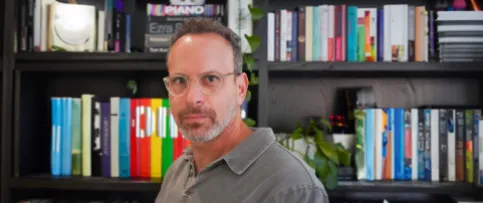Recently licensed architect Yanwen Xiao, AIA, shares his advice on navigating the path to licensure and talks about his experience as a member of NCARB’s Re-Think Tank.
Why did you want to become an architect?
I enjoy anything related to problem-solving. Architects are very good at this in a poetic way.
You studied structural engineering before moving to the United States and earning your Master of Architecture degree. How has that background affected the way you think about architecture?
Engineering training is about quantitative analytical thinking, not just crunching numbers. It has helped me navigate through complex project issues. Architects should have various mental toolboxes—from being able to sketch quickly on tracing paper to generating dozens of ideas—architects should also think with data, process, probability, and more. Some engineering methodology is transferable. In engineering, you never design a system to meet all possible external challenges at the same time: you use methods based on probability to prioritize what to design for. Architects think in a similar but less expressed way; we always have limited resources and design with priorities.
You became licensed just two and a half years after graduating from Clemson. What was navigating the licensure process like for you, and what was your strategy for finishing so quickly?
I was determined to get licensed as fast as possible, so I pivoted everything toward getting involved with the right type of projects and seeking support from my Architectural Experience Program® (AXP™) supervisor and mentors. Too often, if you are not determined, you get carried away as other priorities would always come up.
For me, it was pretty straightforward. To be honest, the architecture license process in my home country is much more onerous, so I find this relieving.
Do you have any study tips for candidates taking the Architect Registration Examination® (ARE®)? How did you stay motivated after facing a setback?
The ARE forum was beneficial. It’s encouraging to see people all over the place working toward the same goal as you. Flashcards are incredibly efficient in learning new terms and concepts as well. Time management is critical; you want to commit to a weekly routine. I studied two to three hours every other night at a Starbucks. As you make progress, it’s satisfying.
The only section I failed was a vignette, and after I doing some research on the ARE forum, I realized I made a dumb mistake, so it wasn’t that discouraging. I wasn’t expecting to pass all divisions on my first attempt, either—just be prepared that you might fail a few times.
How do you think the architecture community can work to increase diversity?
Architecture school is expensive. The cost might be prohibitive for many economically disadvantaged groups. I know the University of Cincinnati has a great program that allows students to alternate between paid internships and taking classes. Innovations in architecture education like this would help in reducing cost and opening doors for a more diverse student base.
How has becoming licensed accelerated your career?
It is definitely a critical milestone. Getting licensed improved my professional credibility in front of the clients, as well as among colleagues and sub-consultants. It gave me a much broader platform to put myself out there to assume more responsibility.
You’re a member of NCARB’s first think tank for recently licensed architects. What has that experience been like?
It was a fantastic experience, and I can’t say enough good things about it. I felt I had the chance to make a difference for our profession. It is eye-opening to work with inspiring peers from all over the country to figure out what we should do next to improve the licensure process for the architecture community.
What advice do you have for candidates going through the licensure process?
Power through, keep the momentum, make it short and quick, and get your license as soon as you can after graduation so that you can focus on your other priorities in life.
Yanwen Xiao is an MBA candidate at Carnegie Mellon University.


